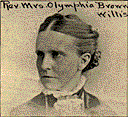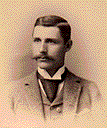

 |
 |
 |
Mrs. Brown became president of the Wisconsin Woman's Suffrage Association in 1885, having been elected at the annual convention in Madison as successor to Mrs. Griswold. She was destined to serve as president for thirty years, never failing in devotion, energy, or efficiency. In 1913 she became honorary president of the association. The first year of Mrs. Brown's presidency was marked by the introduction and passage of a law giving school suffrage to women, contingent upon the favor of the voters at the election in November, 1886. That vote proved favorable, 43,581 votes being cast in favor and 38,988 against such enfranchisement.20 |
|
 John B. Winslow |
The text of the school suffrage law gave rise to complications. It provided that women under proper conditions of sanity, residence, etc., should have a right to vote at "any election pertaining to school matters." The phrase "pertaining to school matters" was ambiguous. Many people believed that the legislature wittingly or unwittingly, had really given full suffrage or nearly full suffrage to women by providing that they might vote at any election pertaining to school matters. Following this assumption, Mrs. Brown and other women attempted to vote at the municipal election in 1887 and in some places their ballots were received. In Racine Mrs. Brown's ballot was rejected and as a test case she brought suit against the election inspectors of that city for refusing to accept her vote. The case was argued before Judge John B. Winslow of the circuit court, later chief justice of the supreme court of Wisconsin, who rendered a decision that under the provision of the law women were entitled to vote at that election and for all candidates. An appeal was taken to the supreme court, which reversed the findings of the lower court, declaring the intent of the law to be to confer school suffrage only. This decision was written by Justice John B. Cassoday. The long litigation cost the little band of suffragists $2,000, which they paid by unremitting devotion and self-sacrifice. The school suffrage law was practically a dead letter until 1901, when an act of the legislature provided separate ballot boxes for women. On April 1, 1902, Wisconsin women voted on the question of issuing certain school bonds. The number of women voting at that time was small, a precedent generally followed while the franchise of women was limited. The small number of women voting on school questions was frequently occasion of reproach to those seeking wider suffrage for women. However, on occasions of especial interest a large women's vote was cast at these elections. In the spring of 1919, when the control of the Milwaukee school board depended on the election of new members, 40,000 Milwaukee women are said to have voted. |
|
 H. M. Youmans |
An important factor in the school suffrage contest and for many years later was the Wisconsin Citizen, organ of the Wisconsin Woman's Suffrage Association, established in 1887. This little sheet of four pages, four columns to the page, appeared every month, the subscription price being twenty-five cents per year.21 Editors from 1887 to 1917, when the paper was discontinued, included Mrs. M. P. Dingee, Racine; Mrs. H. H. Charlton, Brodhead; Miss Lena V. Newman, Brodhead; Mrs. H. M. Youmans, Waukesha. The story of the Citizen, a doughty defender of the faith for three decades, would be of interest, had we space to relate it. It was first published at Racine, later for many years at Brodhead, and still later in Waukesha. After its publication was suspended, monthly bulletins were issued to take its place. |
 |
20 Mrs. Alura Collins Hollister represented the association as chairman of the legislative committee in 1885. See her recent reminiscences in the Waukesha Freeman, on her experiences at that time.
21 The Wisconsin Historical Library has a complete file of The Wisconsin Citizen, the gift of the Reverend Olympia Brown.